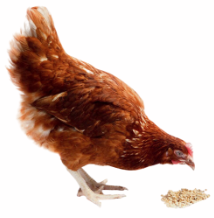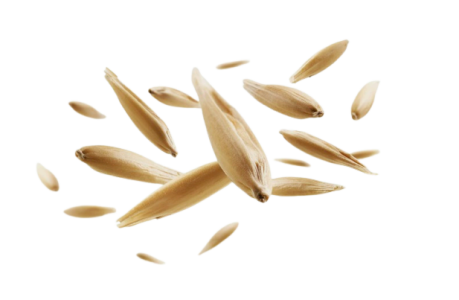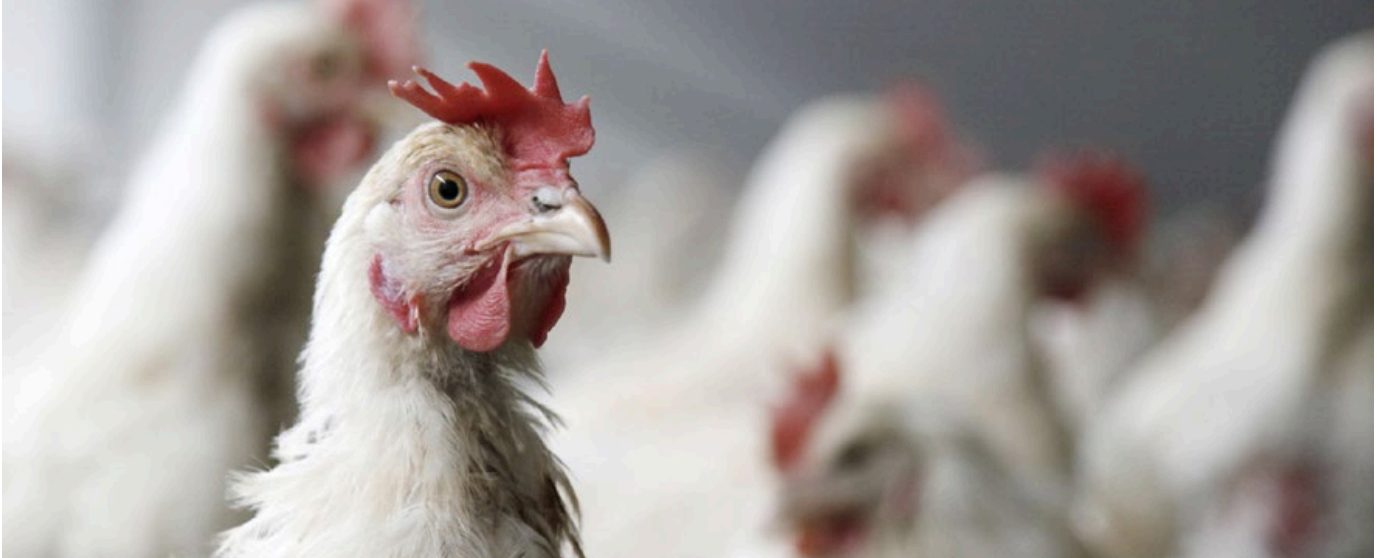Animal Health
Cross Feeding & Intestinal Microbiome: Impact on Monogastric Nutrition & Health
STORE IN THE BOOKSTORE PDFRead more content on nutriNews International December 2023
Animal Health
Read more content on nutriNews International December 2023
Cross Feeding & Intestinal Microbiome: Impact on Monogastric Nutrition & Health
INTRODUCTION
The gastrointestinal tract of birds is home to a diverse community of microorganisms, including bacteria, yeasts, fungi, and viruses.

This community, known as the intestinal microbiome, engages in host immune modulation, nutrient metabolism, competitive exclusion of pathogens, etc. (Berg, G. et al, 2020). Therefore, an optimal and balanced intestinal microbiome is essential for the development of a healthy animal, and a requirement to ensure its best productive performance.
| Therefore, an optimal and balanced intestinal microbiome is essential for the development of a healthy animal, and a requirement to ensure its best productive performance. |
THE INTESTINAL MICROBIOME: A COMPLEX “ECOSYSTEM”
 Microbial colonization of the poultry intestine is a competitive process in which initial colonizers promote or inhibit the establishment of subsequent invaders – either beneficial or detrimental, – by modifying the intestinal microenvironment (e.g., pH) and/or the secretion of metabolites that promote or delay the growth of other microorganisms.
Microbial colonization of the poultry intestine is a competitive process in which initial colonizers promote or inhibit the establishment of subsequent invaders – either beneficial or detrimental, – by modifying the intestinal microenvironment (e.g., pH) and/or the secretion of metabolites that promote or delay the growth of other microorganisms.
![]() The formation of the microbial community in birds is quite fast: one day after hatching, we already find approximately 10 8 and 10 10 bacteria per gram of content in the ileum and cecum, respectively. The latest studies suggest that, rather than due to parental influence, colonization would be due to the environment that surrounds the animals after they hatch. (Stanley et al. 2013).
The formation of the microbial community in birds is quite fast: one day after hatching, we already find approximately 10 8 and 10 10 bacteria per gram of content in the ileum and cecum, respectively. The latest studies suggest that, rather than due to parental influence, colonization would be due to the environment that surrounds the animals after they hatch. (Stanley et al. 2013).

| On the third day of life, these populations increase to 10 9 and 10 11 and remain stable for a time, during which they adapt to environmental changes and to the stressors coming from the host animal (Baldwin et al. 2018). |
 The type of production system (cage, free range, etc.) defines the environment and the type of feeding to which the birds are exposed and, therefore, has a great influence on the microbiota, especially in systems with access to the open air. , in which more strict biosafety systems are replaced by exposure to the microbiota of the soil, water and outdoor vegetation; but, more dangerous, to the microbiota of wild animals (rodents, wild birds, etc.) that increases the load of pathogen agents in poultry (Ocejo et al. 2019 ) .
The type of production system (cage, free range, etc.) defines the environment and the type of feeding to which the birds are exposed and, therefore, has a great influence on the microbiota, especially in systems with access to the open air. , in which more strict biosafety systems are replaced by exposure to the microbiota of the soil, water and outdoor vegetation; but, more dangerous, to the microbiota of wild animals (rodents, wild birds, etc.) that increases the load of pathogen agents in poultry (Ocejo et al. 2019 ) .

 CROSS FEEDING: CONCEPT & BENEFITS
CROSS FEEDING: CONCEPT & BENEFITS
One of the most interesting characteristics of the gut microbiome is its ability to interconnect with other populations. There are different relationships between microbial individuals, such as mutualism, commensalism, amensalism, competition, etc. This is where the concept of “cross-feeding” comes into play.
| This phenomenon is defined as the interaction between diverse groups of microorganisms in the intestine, so that certain metabolites produced by a certain microbial population (from a substrate assimilated by it) serve as nutrients for another population (Yongfei Hu, et al. 2022; Cavalier, M. et al 2017). |
Likewise, the cross feeding may be:

![]() Unidirectional:one community generates secondary metabolites from which another community benefits.
Unidirectional:one community generates secondary metabolites from which another community benefits.
Bidirectional:  when the metabolites generated are exchanged reciprocally between two populations, being a case in which both benefit (D’Souza, G et al., 2018).
when the metabolites generated are exchanged reciprocally between two populations, being a case in which both benefit (D’Souza, G et al., 2018).![]()
| Therefore, cross-feeding a critical aspect to maintain an optimal intestinal microbiome. Several studies have reported the benefits of stimulating cross-feeding between microbiome organisms in the field of animal nutrition, and some of them are: |

Improvement of the digestibility of raw materials: Varied species of saprophytic bacteria collaborate with each other to decompose complex compounds of poor digestibility in monogastric animals, such as cellulose, into nutrients that can be assimilated by both the bacteria themselves and the intestinal cells (Flint, H. J, et al., 2012).

 Production of metabolites that ensure good microbial status: Bacterial communities generate short-chain fatty acids (SCFAs) and B vitamins. These compounds are essential for the development of bacteria and enterocytes, and support the functioning of the immune system. (Ríos-Covián, D. et al., 2016).
Production of metabolites that ensure good microbial status: Bacterial communities generate short-chain fatty acids (SCFAs) and B vitamins. These compounds are essential for the development of bacteria and enterocytes, and support the functioning of the immune system. (Ríos-Covián, D. et al., 2016).

 Competitive and non-competitive exclusion against pathogens: Metabolites exchanged between bacterial populations stimulate the growth of saprophytic bacteria that compete for the same physical space with harmful agents. In addition, saprophytic microorganisms are also capable of establishing communications with pathogens to, for example, prevent their adherence to the surface of intestinal cells (Sekirov, I. et al., 2010).
Competitive and non-competitive exclusion against pathogens: Metabolites exchanged between bacterial populations stimulate the growth of saprophytic bacteria that compete for the same physical space with harmful agents. In addition, saprophytic microorganisms are also capable of establishing communications with pathogens to, for example, prevent their adherence to the surface of intestinal cells (Sekirov, I. et al., 2010).
![]()
 Greater productive efficiency: As there are improvements over gut health, the capacity for digestion and absorption of nutrients is increased, which leads to an improvement in productive indexes (Pluske, J. R et al., 2018).
Greater productive efficiency: As there are improvements over gut health, the capacity for digestion and absorption of nutrients is increased, which leads to an improvement in productive indexes (Pluske, J. R et al., 2018).
STRATEGIES TO STIMULATE CROSS FEEDING:
We cannot talk about good animal nutrition without a correct intestinal microbiome, and this can be achieved by ”feeding” the populations of saprophytic bacteria. To stimulate the growth of bacterial colonies and the cross-feeding among them, poultry farming’ professionals have at their disposal, different nutritional plans and strategies. Some of the most common approaches are:
 Use of probiotics and prebiotics: The administration of probiotics (live microorganisms that confer health benefits) and prebiotics (non-digestible substances that stimulate the growth of saprophytic bacteria) in poultry diets is a common action when digestive problems appear.
Use of probiotics and prebiotics: The administration of probiotics (live microorganisms that confer health benefits) and prebiotics (non-digestible substances that stimulate the growth of saprophytic bacteria) in poultry diets is a common action when digestive problems appear.
![]() The effectiveness of including synthetic microbiome with an in ovo injection to establish a standardized bacterial population prior to hatching has been demonstrated (Yongfei Hu, et al. 2022).
The effectiveness of including synthetic microbiome with an in ovo injection to establish a standardized bacterial population prior to hatching has been demonstrated (Yongfei Hu, et al. 2022).
![]() Studies indicate that the administration of XOS increases the population of butyrate-producing bacteria in the cecum and lactobacilli in the colon, confirming that cross-feeding occurs. (Maesschalck et al. 2015)
Studies indicate that the administration of XOS increases the population of butyrate-producing bacteria in the cecum and lactobacilli in the colon, confirming that cross-feeding occurs. (Maesschalck et al. 2015)


The quality of raw materials: Provide high-quality fiber sources in the diet (oat hulls, wheat bran, beet pulp, etc.) that can be assimilated by the intestinal microbiota; and from there beneficial metabolites can be generated. Furthermore, we must assess the absence of other aspects that can worsen the quality and digestibility of the raw materials, such as excess anti-nutritional factors or the presence of mycotoxins.
 Use of enzymes : The addition of enzymes in feed helps to break down macromolecules such as non-starch polysaccharides (NSP), phytic acid, starch or proteins, to make them more assimilable by the microbiome and so that it can produce metabolites that benefit other bacteria in their environment (Bedford, M et al, 2022).
Use of enzymes : The addition of enzymes in feed helps to break down macromolecules such as non-starch polysaccharides (NSP), phytic acid, starch or proteins, to make them more assimilable by the microbiome and so that it can produce metabolites that benefit other bacteria in their environment (Bedford, M et al, 2022).

Control of intestinal pH: Maintaining an adequate intestinal pH favors the growth and functionality of certain populations of saprophytic bacteria, as well as the morphology and physiology of enterocytes. The use of acidifiers in drinking water can be of major help to achieve this purpose (Fathima, S. et al., 2022).
Use of botanicals: The inclusion of additives based on phytogenic active compounds phytobiotic and/or nutraceuticals in the diet of production animals is nowadays one of the most common tools used in the feed industry to support the maintenance of a proper gut health while fully complying at the same time, with the strict regulations related to the use of antimicrobials. Numerous research studies have shown consistently the activity of certain active components derived from botanical components over pathogenic agents such as Clostridium sp; Eimeria sp., Streptococcus sp… (Bozkur et al.,2013; Elsayed et al. 2020; Fabiana C. de Aguiar et al. 2018)
Furthermore, the use of botanical compounds has emerged as a nutritional support in case of liver problems, leading into improvements over the feed efficiency and how the animals take advantage of all the nutrients provided in the diet. (Hossein Zaker et al., 2020; Gillessen et al., 2020)
Combined solutions or products: interconnecting the previously mentioned strategies is also a remarkably interesting option, developing specific products that contain probiotics and prebiotics, enzymes, organic acids, and botanical derivatives.
| In this sense, the R&D strategies of the companies are focusing on maximizing the synergies between the different compounds in order to take advantage of the cross-feeding phenomenon and, consequently improve animal health and zootechnical performance (Yaqoob, MU, et al 2021). |

CONCLUSIONS
|
The preservation of intestinal health throughout the birds’ productive life is a continuous task and subject to evolution. Problems may arise at the beginning of the productive life, due to poor colonization of the intestinal tract; However, commercially we have strategies to support the physiology of beneficial bacteria that, thanks to the cross- feeding, collaborate as a unique ecosystem, and they compete with other pathogenic microorganisms. |
 If we learn to approach all these strategies together, we can achieve great benefits in the productive performance of our farms.
If we learn to approach all these strategies together, we can achieve great benefits in the productive performance of our farms.

You may also like to read: “Mycotoxin control: Focusing on the problem”
MORE CONTENTS Liptosa-